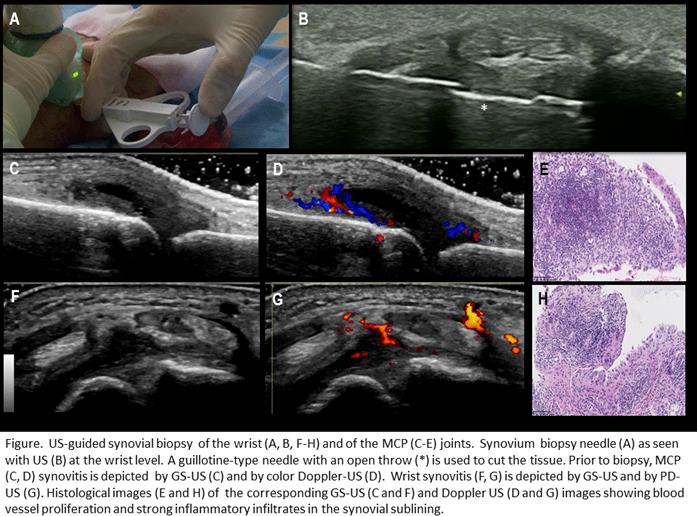Session Information
Date: Sunday, November 13, 2016
Title: Imaging of Rheumatic Diseases - Poster I: Ultrasound and Emerging Technologies
Session Type: ACR Poster Session A
Session Time: 9:00AM-11:00AM
Background/Purpose:
The development of ultrasound-guided synovial biopsy will enable synovial tissue collection from small joints and will facilitate molecular studies, thus improving the understanding of mechanisms of inflammatory arthropathies as small joints are frequently involved in these diseases. Objective: To assess the safety, tolerability and feasibility to perform synovial biopsies from wrist and metacarpophalangeal (MCP) joints, using a minimally invasive ultrasound (US)-guided technique in patients suffering from rheumatoid arthritis (RA), spondylarthropathies (SA) or undifferentiated arthritis (UA).Methods:
Two target joints (TJ) were biopsied: wrist and MCP. Patients with at least one clinically swollen joint at these levels, suffering from RA, SA, or UA underwent a US examination. The TJ chosen for the biopsy was the joint with the most important inflammatory changes on gray-scale (GS) US. GS synovitis and power-Doppler (PD) activity were assessed by OMERACT scores, on the day of the biopsy, as well as 2 weeks (w), 6w and 6 months (m) after the biopsy. In addition, tendon tears, hematoma, paratenonitis and tenosynovitis were searched on US examinations. Patient-reported outcomes (PRO) were assessed as previously described1. A standard questionnaire (pain, swelling and stiffness of the TJ using a visual analogue scale from 0 to 10) was given to all patients on the day of the biopsy as well as 1w, 2w, and 6w after the biopsy. Tolerability and the patient-reported willingness to repeat the procedure was assessed using the five-point Likert scaleResults:
56 patients suffering from RA (36), SA (9) and UA (11) underwent US-guided biopsy of the wrists (28) and MCP (28) joints (Figure). A non-significant increase in pain 24 h after the procedure was reported by all except one patient. No difference in PRO of the biopsied joints was reported 2w and 6w after the biopsy, as compared to assessment before the biopsy. No infection or haemorrhage was observed after the biopsy. No differences in PRO after the biopsy were observed between patients suffering from RA, SA or UA. We registered three adverse events specifically linked to the procedure: persistent thumb hypoesthesia (1 patient), hypotension (vagal reaction) during the procedure (2 patients). At 6w and 6m follow-up, no other safety concerns were reported. At the TJ, US scores tended to decrease 2w after the procedure. Treatment response at the TJ was similar to the response of non-biopsied joints matched for the baseline US parameters.Conclusion:
With the exception of study of Kelly et al, data on safety, tolerability, feasibility and PRO using minimally invasive US-guided biopsy are lacking. In this work, we confirm that US-guided biopsy of wrist and MCP joints is feasible, safe and well tolerated by patients. Furthermore, no differences in PRO between RA, SA and UA were observed. As for any other innovative tool, this technique should be compared with other available techniques of synovial biopsy. 1Kelly S. et al. Ultrasound-guided synovial biopsy: a safe, well-tolerated and reliable technique for obtaining high-quality synovial tissue from both large and small joints in early arthritis patients. Ann Rheum Dis. 2015;74:611-6117. We acknowledge Pr C. Pitzalis and S. Kelly for giving us the opportunity to learn and further disseminate minimally invasive ultrasound-guided technique, and for fruitful discussions.
Disclosure: L. Meric de Bellefon, None; P. Durez, None; C. Galant, None; A. Nzeusseu Toukap, None; A. Avramovska, None; B. R. Lauwerys, None; F. A. Houssiau, None; M. S. Stoenoiu, None.
To cite this abstract in AMA style:
Meric de Bellefon L, Durez P, Galant C, Nzeusseu Toukap A, Avramovska A, Lauwerys BR, Houssiau FA, Stoenoiu MS. Safety, Tolerability and Feasibility of Minimally Invasive Ultrasound-Guided Synovial Biopsyof Wrist and Metacarpophalangeal Joints – an Ultrasound Follow-up Study [abstract]. Arthritis Rheumatol. 2016; 68 (suppl 10). https://acrabstracts.org/abstract/safety-tolerability-and-feasibility-of-minimally-invasive-ultrasound-guided-synovial-biopsyof-wrist-and-metacarpophalangeal-joints-an-ultrasound-follow-up-study/. Accessed .« Back to 2016 ACR/ARHP Annual Meeting
ACR Meeting Abstracts - https://acrabstracts.org/abstract/safety-tolerability-and-feasibility-of-minimally-invasive-ultrasound-guided-synovial-biopsyof-wrist-and-metacarpophalangeal-joints-an-ultrasound-follow-up-study/
